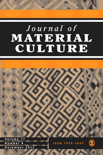
JOURNAL OF MATERIAL CULTURE
Scope & Guideline
Connecting Past and Present Through Material Insights
Introduction
Aims and Scopes
- Material Agency:
Explores how objects influence human behavior and social interactions, emphasizing the active role of materiality in shaping cultural practices. - Cultural Memory and Identity:
Investigates the relationship between objects and memory, identity formation, and the ways that material culture can signify personal and collective narratives. - Temporal and Spatial Dynamics of Objects:
Examines how objects change meaning over time and across spaces, including their roles in various socio-political contexts and historical narratives. - Affective Materiality:
Focuses on the emotional and sensory experiences associated with objects, exploring how material culture can evoke feelings and memories. - Sustainability and Ethics in Material Culture:
Analyzes the implications of material practices in terms of sustainability, ethical consumption, and the socio-political impacts of material choices. - Transdisciplinary Approaches to Material Culture:
Encourages collaboration across disciplines to better understand the complex relationships between materials, culture, and societal structures.
Trending and Emerging
- Impact of Digital Media on Material Culture:
An increasing number of studies explore how digital technologies influence material practices, such as online communities shaping the meanings of objects and digital representations of cultural heritage. - Material Culture in Conflict and Post-Conflict Contexts:
There is a growing focus on how material culture is implicated in narratives of conflict, trauma, and healing, especially in relation to displaced communities and the aftermath of violence. - Gender and Materiality:
Research examining the intersections of gender and material culture is gaining traction, addressing how gender identities and roles are expressed and negotiated through objects. - Environmental Sustainability and Material Practices:
Emerging themes highlight the relationship between material culture and environmental issues, particularly how sustainable practices can reshape consumer habits and cultural values. - Affective and Sensory Engagement with Objects:
An increasing emphasis on the emotional and sensory experiences associated with objects signifies a trend toward understanding materiality through the lens of affect theory.
Declining or Waning
- Traditional Ethnographic Studies:
Papers that strictly adhere to traditional ethnographic methodologies are becoming less prevalent, as the journal increasingly embraces innovative and interdisciplinary approaches. - Static Representations of Material Culture:
There appears to be a waning interest in studies that treat material culture as fixed or unchanging, with a growing preference for dynamic interpretations that account for the fluidity of meaning. - Overly Theoretical Discussions:
The journal has shifted focus away from highly abstract theoretical discussions about material culture, favoring empirical case studies that provide concrete examples and applications.
Similar Journals

Ethnoarchaeology
Innovating Insights: Discovering Cultural Narratives Through EthnoarchaeologyEthnoarchaeology, published by ROUTLEDGE JOURNALS, TAYLOR & FRANCIS LTD, stands at the forefront of interdisciplinary research within the realms of anthropology and archaeology. With an ISSN of 1944-2904 and an E-ISSN of 1944-2890, this journal has demonstrated an impressive impact, categorized in the Q1 quartile for both anthropology and archaeology as of 2023. Acknowledged for its influence, it ranks 72/413 in Archeology (arts and humanities) with an impressive 82nd percentile, making it a vital resource for researchers and practitioners. Over its converged years from 2014 to 2024, the journal aims to bridge theoretical and practical aspects of ethnoarchaeology, fostering a deeper understanding of cultural practices through archaeological perspectives. Its commitment to advancing knowledge in this unique field is of utmost importance for academics, professionals, and students dedicated to exploring the interplay between contemporary societies and historical archaeological practices.
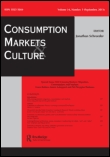
Consumption Markets & Culture
Exploring the Intersections of Consumption and CultureConsumption Markets & Culture is a premier academic journal published by Routledge Journals, Taylor & Francis Ltd, focusing on the interdisciplinary exploration of consumption practices and their cultural significance. As a vital platform for researchers in the fields of Anthropology, Economics, Marketing, and Social Psychology, this journal offers insightful analyses and innovative perspectives that contribute to a deeper understanding of market dynamics and consumer behavior. With a commendable 2023 impact factor placing it in the first quartile for Anthropology and second quartiles for Economics, Marketing, and Social Psychology, the journal ensures rigorous peer review and high-quality scholarship. Researchers and practitioners can expect access to a wealth of knowledge that is crucial for advancing theoretical frameworks and practical applications within the global marketplace. Its indexing in Scopus and substantial visibility in academic circles make it an essential resource for anyone dedicated to the study of consumption in contemporary culture.
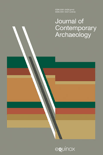
Journal of Contemporary Archaeology
Unveiling the Relevance of Archaeology in Modern SocietyJournal of Contemporary Archaeology, published by EQUINOX PUBLISHING LTD, is an esteemed peer-reviewed journal dedicated to advancing the field of archaeology through the exploration of contemporary issues, innovations, and methodologies. Since its inception in 2014, the journal has become a vital platform, fostering interdisciplinary dialogue and scholarly communication among researchers, professionals, and students alike. With a notable Q2 ranking in both the Archaeology and Arts and Humanities categories, it is recognized for its significant contributions to the academic discourse and its commitment to rigorous scholarly standards. The journal is indexed in Scopus, ranking in the 76th percentile within the Arts and Humanities and the 73rd percentile within the Social Sciences. By providing a comprehensive and open-access approach to archaeological studies, the Journal of Contemporary Archaeology is poised to facilitate exploration and understanding of the dynamic relationships between past cultures and contemporary society. Researchers are encouraged to engage with and contribute to this influential journal based in the United Kingdom.
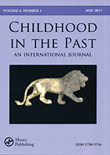
Childhood in the Past
Revealing the stories of childhood that shaped our world.Childhood in the Past is a pivotal academic journal published by Taylor & Francis Ltd, dedicated to exploring the historical perspectives of childhood through a multidisciplinary lens. With an ISSN of 1758-5716 and E-ISSN 2040-8528, this esteemed journal analyzes and contextualizes childhood across various cultures and eras, significantly contributing to the fields of Anthropology and Life-span and Life-course Studies. Despite the absence of Open Access options, the journal holds an impressive Q2 ranking in Anthropology and a Q4 ranking in Life-span and Life-course Studies, reflecting its valuable scholarly contributions. Researchers and students alike can benefit from its insights, given its Scopus rankings — placing it in the 51st percentile for Anthropology and 18th percentile for Life-span studies. Published in the United Kingdom and facilitating an engaging dialogue on childhood history, Childhood in the Past continues its quest from 2014 to 2024 to deepen the understanding of how childhood has shaped societies and continues to evolve today.

ARCHAEOLOGY IN OCEANIA
Delving into the Archaeological Treasures of OceaniaARCHAEOLOGY IN OCEANIA, published by Wiley, is a leading journal that delves into the rich and diverse archaeological landscape of the Pacific region. With a commitment to advancing knowledge in anthropology and archaeology, this esteemed publication has been pivotal in shaping scholarly discussions since its inception in 1966. Spanning generations of research, it has seen converged years of publication from 1966 to 1980 and from 2002 to 2024. With an impressive Scopus ranking placing it in the top quartiles across multiple categories - including Q2 in Anthropology and Q1 in Archeology (arts and humanities) - the journal distinguishes itself as a must-read for researchers, professionals, and students alike. Although it operates on a subscription model, its rigorous peer-reviewed articles and comprehensive studies contribute significantly to understanding the past of Oceania, making it an essential resource for those invested in this vibrant field of study.
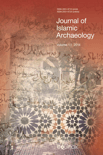
Journal of Islamic Archaeology
Illuminating the Past Through Islamic PerspectivesJournal of Islamic Archaeology is a distinguished publication dedicated to advancing the field of archaeology through the lens of Islamic heritage and culture. Published by EQUINOX PUBLISHING LTD, this journal provides a platform for researchers, professionals, and students to disseminate their findings and engage in critical dialogue regarding the archaeological aspects of Islamic societies from 2014 to the present. With an ISSN of 2051-9710 and E-ISSN 2051-9729, the journal is indexed within significant academic databases and positioned notably in the Q3 and Q2 quartiles for archaeology in the Arts and Humanities and Social Sciences categories, respectively. The journal fosters scholarly exchange and innovation, drawing attention to the rich tapestry of Islamic archaeology, and securing its role as an essential resource for practitioners and academics alike. Its commitment to rigorous peer-review and high-quality contributions ensures a valuable repository of knowledge, enhancing the understanding of an often underrepresented field in archaeology.

Time & Mind-The Journal of Archaeology Consciousness and Culture
Bridging Archaeology and ConsciousnessTime & Mind - The Journal of Archaeology Consciousness and Culture, published by Routledge Journals, Taylor & Francis Ltd, stands at the intersection of archaeology and consciousness studies, revealing the intricate relationship between cultural practices and human cognition. With a robust ISSN of 1751-696X and an E-ISSN of 1751-6978, this esteemed journal plays a vital role in fostering interdisciplinary dialogue among scholars in the realms of anthropology and archaeology. Notably recognized for its rigorous academic standards, it achieved a commendable Q2 category ranking across various fields in 2023, including Anthropology and Archeology, alongside impressive Scopus rankings. As it continues to publish cutting-edge research from 2008 to 2024, this journal remains dedicated to exploring the nuances of human experience through the lens of archaeological evidence, making it an indispensable resource for researchers, professionals, and students alike seeking to deepen their understanding of the cultural dimensions of consciousness.
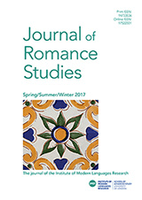
Journal of Romance Studies
Fostering Scholarly Dialogue in Romance DisciplinesJournal of Romance Studies, published by Liverpool University Press, is a significant forum for scholarly discourse within the realms of cultural studies, linguistics, literature, and the visual and performing arts. With an ISSN of 1473-3536 and an E-ISSN of 1752-2331, this journal aims to bridge various interdisciplinary approaches, fostering insights into the richness of Romance languages and their cultural contexts. Although it holds a Q4 designation across several categories in the 2023 rankings, the journal continues to serve as a platform for emerging researchers and established scholars alike to contribute to the evolving narrative of Romance studies. Published annually, it ensures access to a diverse body of research that underpins the understanding and critique of Romance languages and cultures. Join a community committed to exploring these vital areas of inquiry, as the journal actively engages with contemporary issues shaping the landscape of Romance studies.

Kiva-Journal of Southwestern Anthropology and History
Unveiling the Past: Insights from the SouthwestKiva - Journal of Southwestern Anthropology and History is a distinguished academic journal published by Routledge Journals, Taylor & Francis Ltd, that serves as a vital resource for scholars in the fields of anthropology, archaeology, and history. With an ISSN of 0023-1940 and an E-ISSN of 2051-6177, this journal has established itself as a significant avenue for scholarly communication since its inception in 1964. It consistently ranks in the top quartiles, including Q1 in Archaeology and Q2 in Anthropology, reflecting its high impact and rigorous peer-review process. Covering a wide array of topics pertinent to the Southwestern United States, Kiva invites original research articles, reviews, and methodological papers that advance understanding of the region's rich cultural heritage and historical narratives. While currently not open access, its commitment to disseminating quality research makes it an essential reading for researchers, professionals, and students aiming to explore the multifaceted dimensions of southwestern studies.

ARYS-Antiguedad Religiones y Sociedades
Illuminating Ancient Beliefs and Their Societal EchoesARYS-Antiguedad Religiones y Sociedades is a prestigious academic journal published by UNIV CARLOS III MADRID, INST HISTORIOGRAFIA JULIO CARO BAROJA that focuses on the intricate relationships between ancient religions and societies. With an ISSN of 1575-166X and an E-ISSN of 2173-6847, this journal has established itself as an influential platform for scholarly discourse from 2019 to 2023, achieving a commendable Q2 ranking in both History and Religious Studies categories. Despite not being an open-access journal, it offers valuable insights for researchers and professionals delving into the historical contexts of religious beliefs and their societal implications. The journal's rigorously peer-reviewed content aims to foster a deeper understanding of ancient civilizations and their spiritual practices, making it an essential resource for academics, students, and practitioners in the fields of history and religious studies. Join the growing community of scholars who contribute to and benefit from the rich tapestry of knowledge presented in ARYS-Antiguedad Religiones y Sociedades.